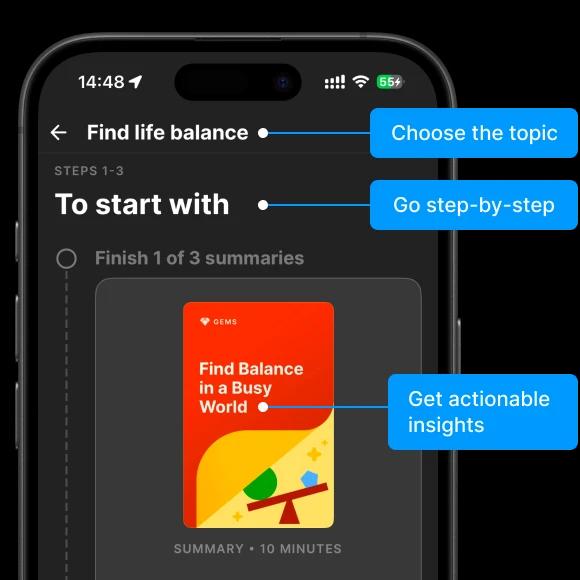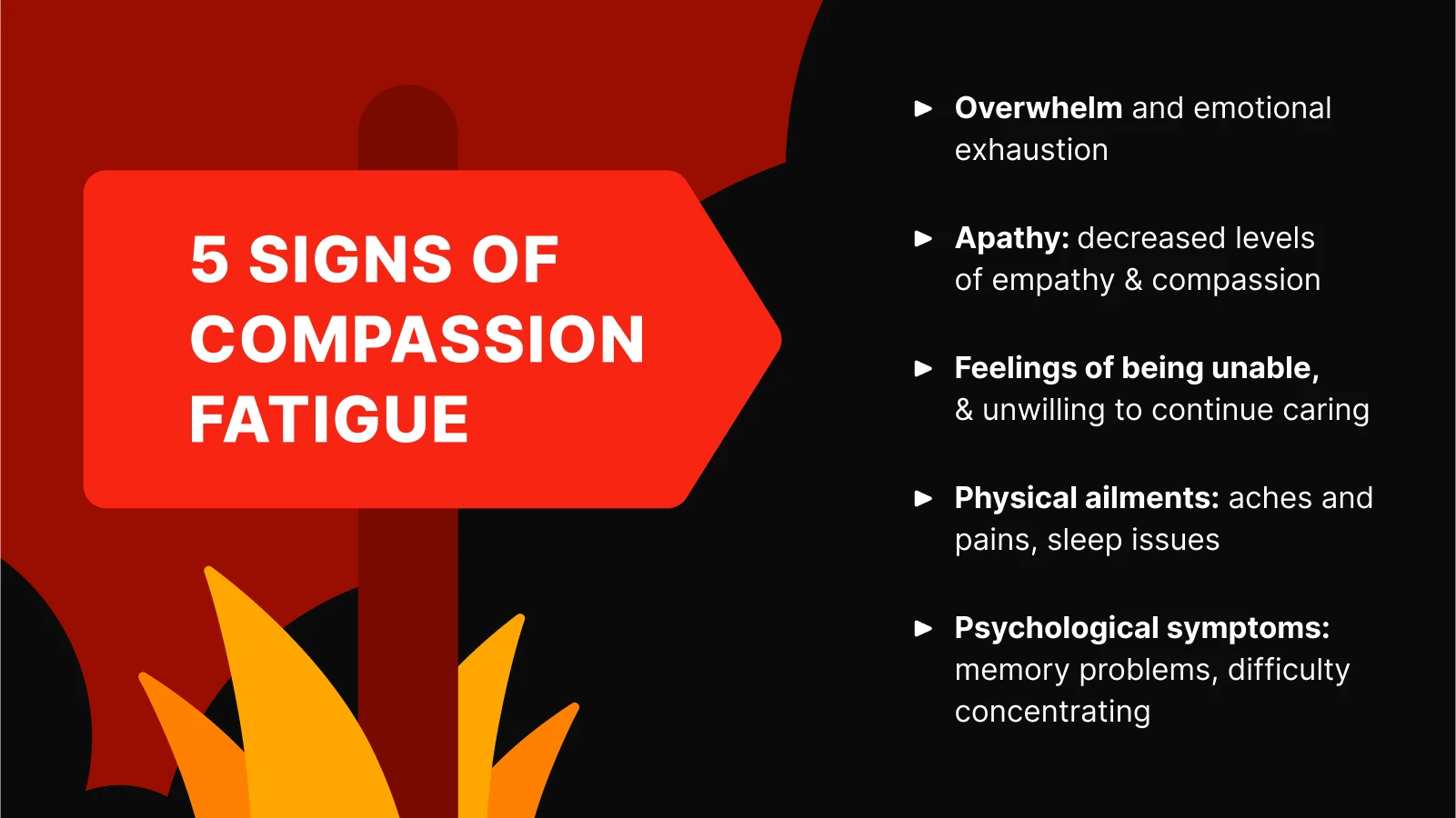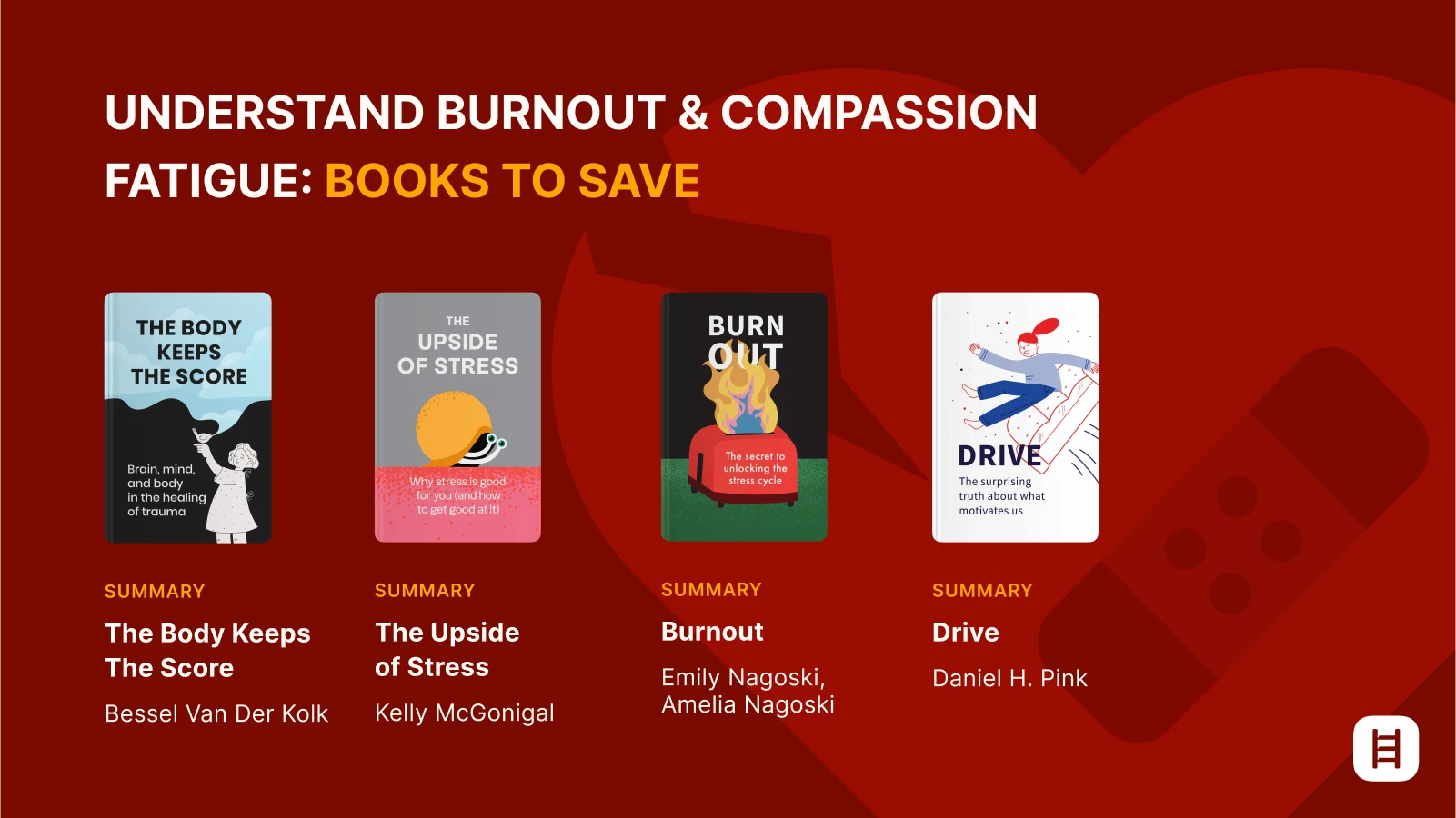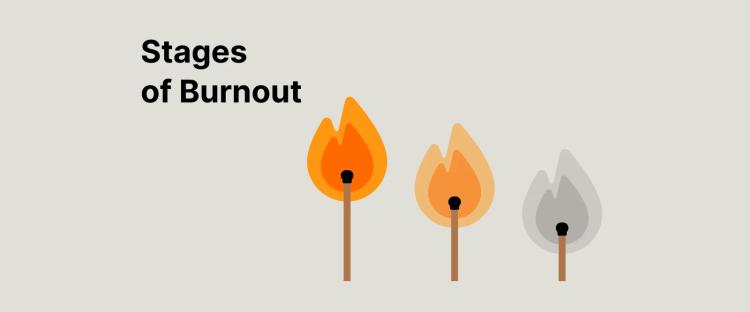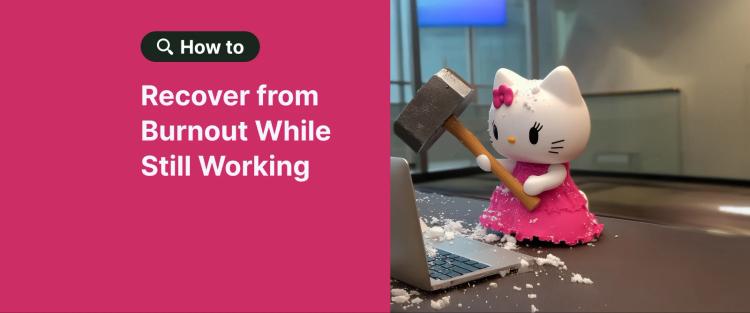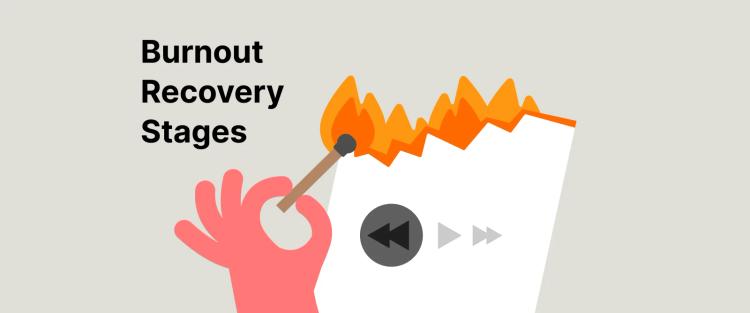Compassion fatigue and burnout are two different conditions that people in high-stress helping professions often experience, both negatively affecting mental health. The main difference is that compassion fatigue results from caring too much, and burnout describes a state where you just can't care anymore.
Put simply, compassion fatigue is empathy-driven exhaustion resulting from caring for others in distress, whereas burnout is performance-related exhaustion stemming from chronic workplace stress.
While similar in some ways, each condition requires different self-care techniques for recovery.
As a licensed counselor and professor with decades of experience, I've seen firsthand how identifying the right condition can dramatically improve a person's ability to heal. I'm Suzanne Degges-White, PhD, LCPC, LPC, LMHC, NCC, and I am the Professor and Chair of the Department of Counseling and Higher Education at Northern Illinois University.
I've created this guide to help you understand the key differences between compassion fatigue and burnout, and guide you toward recovery using evidence-based strategies and curated book recommendations.
Seeking more insights on different, complex topics? Headway, a daily growth app, features a comprehensive library of nonfiction bestsellers (2000+ summaries), providing valuable insights to support your personal development. Don't put things off until tomorrow — Download the Headway app today!
Quick summary: Compassion fatigue vs burnout
Compassion Fatigue = Emotional exhaustion from caring too much for others in distress.
Burnout = Emotional and physical depletion from prolonged workplace stress and lack of control.
Compassion fatigue is empathy-based; burnout is productivity-based.
What is compassion fatigue?
Compassion fatigue is a term initially coined to describe the overwhelming emotional fatigue experienced by emergency room nurses. It affects people's physical health, emotional well-being, and mental state. It is experienced by people who feel a high level of empathy toward others in situations where there is a large amount of suffering.
Five warning signs of compassion fatigue
The symptoms of compassion fatigue include:
Overwhelm and emotional exhaustion that make it difficult to be fully present on the job.
Apathy, with decreased levels of empathy and compassion for others.
Feelings of being unable, but also unwilling, to continue caring.
Physical ailments including aches and pains, sleep issues, and a compromised immune system.
Psychological symptoms include memory problems, difficulty concentrating, and impaired decision-making.
Medical and mental health care workers are highly prone to compassion fatigue. People who provide unpaid caregiving to family members or others are also at risk. All of these individuals bear a high level of responsibility for the well-being of others. When coupled with high-stress situations, patient care may suffer when the burden of caring reaches a tipping point.
The tipping point, where a person's compassion and empathy tap out, can be reached as a result of prolonged exposure to others' trauma. Vicarious trauma or secondary traumatic stress, which is hearing another's stories of trauma or working with those who have experienced past trauma, is a risk factor.
As Bessel van der Kolk explores in 'The Body Keeps the Score,' the psychological toll of vicarious trauma can manifest physically and emotionally. Providers who internalize the pain of others may not realize how deeply these stories affect their bodies and minds until symptoms of compassion fatigue emerge.
Long-term caregiving, even for loved ones, can lead to compassion fatigue over time. This reality is especially true if their loved one needs a great deal of care or if the caregiver lacks an adequate social support network, and their personal life suffers.
Individual traits, such as weak boundaries, can also increase the likelihood of compassion fatigue. If left untreated, compassion fatigue can transform into burnout, which becomes even harder to manage.
What is burnout?
Burnout has been described as a combination of detachment, exhaustion, and diminished effectiveness and productivity on the job. Burnout occurs in workplace or life situations where a person faces excessive expectations regarding performance, but has too little control. An unhealthy work environment and coping strategies are key markers of a person's potential for burnout.
The symptoms of burnout include:
Apathy and detachment, including difficulty concentrating, trouble making decisions, and a lack of commitment to tasks.
Loss of enjoyment and engagement in life, with feelings that your contributions have no value to others.
Irritability, anger, and social withdrawal, leading to unhealthy coping strategies.
Physical ailments like aches and pains, sleep issues, and a weakened immune system.
Behavioral changes, such as procrastination, showing up late, or missing work.
Burnout can affect anyone who feels they are being asked to do more than is possible given the resources available, such as time, skills, and space. Burnout has different stages and is typically a result of chronic workplace stress and the feeling that too much is expected from others or oneself.
That's why entrepreneurs, company founders, executive-level employees, and professionals in high-demand fields commonly face burnout. Educators, medical and mental health care workers, students, remote workers, and caregivers are also prone to burnout.
Burnout occurs when there is a mismatch between what is expected of a person on the job and what they are able to give to the job.
Five common causes of burnout:
Lack of control at work
Excessive workload
Unclear or conflicting expectations from leadership
Feeling unappreciated or unsupported
Value conflict between personal ethics and job demands
Difference between burnout and compassion fatigue
There are key differences between compassion fatigue and burnout. These differences include the root cause of the condition, the timeline of onset, and the focus of the respective maladaptive responses.
| Compassion fatigue | Burnout |
|---|---|
Relationship-related and arises from continuous exposure to the suffering of those you are there to care for | Workplace-related issues that arise from unhealthy work-life conditions, including chronic stress or overload |
The more a person cares for the well-being of others, the higher the likelihood they will experience compassion fatigue | The greater the demands of the workplace, and the less control over the job given to workers, the greater the possibility that burnout will happen |
Emotional engagement with others feeds the fatigue | In burnout, there is little capacity to engage with others at work or in social settings |
Caring too much and trying too hard raises the risk of onset | In burnout, a person is no longer able to care about the job |
Empathy and compassion-related exhaustion are involved | Work-related stress and performance inefficiency are involved |
Sudden or acute onset — it lands with a wallop! | Develops gradually over time as workplace demands and expectations become increasingly overwhelming |
How can you tell the difference between burnout and compassion fatigue?
Several overlapping traits exist between these two conditions that can be confusing to some. These shared traits include emotional exhaustion, feelings of numbness, and indifference towards life. They also share symptoms related to physical well-being and mental sharpness, which are compromised in both conditions.
Understanding your emotional responses is essential when distinguishing between these two conditions. As explained in 'Emotional Intelligence' by Daniel Goleman, recognizing and managing your emotional state helps prevent empathy overload and decision fatigue — both of which are common in compassion fatigue and burnout.
If any of these symptoms sound familiar, here's a self-check quiz to help you determine whether you may be suffering from one of these conditions:
Why the difference matters for your personal growth and wellness
While symptoms may be similar, knowing which struggle you are facing is essential. Compassion fatigue arises from carrying a heavy load of empathy and caring a great deal for others; burnout typically arises from external and untenable working conditions.
This key distinction is crucial to understand, as each condition is best treated in a different way. The better you understand the cause of your physical and psychological symptoms, the quicker you can begin the healing process.
While self-care is essential for addressing both conditions, it is vital to distinguish which recovery method is most appropriate. In compassion fatigue, the cause is rooted in overexposure to other people's suffering, both in time and intensity. The longer you delay addressing the problem, the greater the chance that it will push you toward burnout.
Burnout often strips away the internal motivation that once made work meaningful. In the 'Drive' summary, Daniel H. Pink highlights how purpose, autonomy, and mastery are key drivers of fulfillment — elements that are frequently missing when burnout takes hold.
Once a person reaches burnout, it is difficult for them to find their groove, and engage in their current job, or have the energy to seek out a new position.
How do you recover from burnout vs compassion fatigue?
Most people choose careers based on their interests and life goals, which can set the stage for career satisfaction. But there are some pitfalls that people might not realize until they find themselves feeling exhausted or losing motivation for their jobs.
For people who spend their time caring for the needs of others, compassion fatigue is a strong sign that they need to care for themselves.
Tips to recover from compassion fatigue
Here are some self-care steps for compassion fatigue:
Seek more information on compassion fatigue to identify which self-care techniques work best for you. Resources like Headway provide a great deal of valuable information.
Put on your own oxygen mask first. Focus on your own needs and prioritize your physical and mental health.
Ask for support from others. Seek supervision, debrief with colleagues in similar roles, find a therapist, or join a support group.
Set clear boundaries. Prioritizing your well-being is essential self-care. Say "no" when asked for more than you can give.
Limit your exposure to traumatic content and situations where you cannot offer the empathy expected of you.
Cut yourself a break and give yourself space and time to recover. It could be decompression time between work and home, or a true vacation where you leave the laptop and work phone behind.
Tips to recover from burnout
Everyone in high-stress occupations, including teachers, lawyers, customer service representatives, entrepreneurs, and C-suite executives, runs the risk of burnout. Here are some self-care steps for burnout:
Learn more about burnout from apps like Headway to identify effective self-help techniques.
Assess your stressors. Identify where you experience the greatest tension and create a plan to address it. This shift could mean a revised work schedule, different working conditions, or a shift in your position.
Prioritize work-life balance ASAP. Constant pressure takes a toll, so find ways to decompress and restore balance.
Seek support from others. Reach out to your supervisor about reducing workplace demands, talk to your human resources contact, or find a therapist. Consider attending Workaholics Anonymous meetings, if appropriate.
Practice mindfulness and relaxation. Yoga, tai chi, breathing exercises, and meditation provide mental breaks and reconnect you to the present moment.
As psychologist Kelly McGonigal explains in 'The Upside of Stress,' reframing stress as a signal of engagement rather than harm can shift how we respond to pressure. This mindset is especially valuable for healthcare professionals and social workers seeking to recover from burnout without exiting the profession entirely.
Burnout is accompanied by a loss of meaning and disengagement from the job. Engage in new creative outlets and allow yourself to get back in touch with what drew you to your career path.
For both compassion fatigue and burnout, online resources such as Headway can support recovery, healing, and prevention of these conditions in the future. This site offers articles, self-help resources, and summaries of books that can help transform your approach to work and life.
Five best books to understand burnout and compassion fatigue
There is a wide range of online resources available that provide easy-to-access and easy-to-understand information, as well as helpful books. You can find book summaries on the Headway app that can deepen your knowledge. For instance, 'Burnout' by Emily & Amelia Nagoski provides valuable information on shutting down the stress cycle, which can enhance overall well-being.
It breaks down the biology of stress and how the cultural environment amplifies pressure, and it offers advice and practical exercises for recovering from burnout.
Other book summaries include:
'Emotional Intelligence' by Daniel Goleman: This book helps you better understand the ways in which emotional intelligence can best be used to find personal and professional success.
'The Body Keeps the Score' by Bessel van der Kolk: This is the classic book for understanding how trauma, including being a victim of abusive relationships, affects the body and provides helpful suggestions for personal growth.
'The Upside of Stress' by Kelly McGonigal: In this book, McGonical shares a new way of looking at stress that can enhance your ability to handle it and to refocus your energy.
'Drive' by Daniel H. Pink: This book addresses the importance of intrinsic motivation, which is essential to satisfaction on the job.
Read or listen to the full summaries in the Headway app and take the first step toward emotional clarity.
Nab expert insights on compassion fatigue and burnout in the Headway app!
Understanding the difference between compassion fatigue and burnout is the first step toward meaningful recovery. While both conditions share symptoms like mental exhaustion and detachment, they stem from very different causes, and knowing which one you're dealing with is essential to choosing the right path forward.
The Headway app can help you make that distinction clearer. In just 15 minutes a day, you can explore bite-sized summaries of the best books on mental health, stress, resilience, emotional intelligence, and burnout recovery — all tailored for busy people who want real insights fast.
Whether you're experiencing empathy overload or workplace stress, Headway gives you the tools to understand what's happening and what to do next. Don't wait for burnout to take hold. Start with small, daily learning steps that can restore your clarity, motivation, and emotional well-being — Download Headway.
FAQs about compassion fatigue and burnout
What are the five stages of compassion fatigue?
The five stages of compassion fatigue include zealot phase, irritability, withdrawal, depersonalization, and compassion fatigue proper. These stages reflect the slow erosion of empathy and joy that many providers, like social workers and clinicians, experience when continuously exposed to traumatic events — a process sometimes called the cost of caring.
How can I fix empathy burnout?
Providers should prioritize self-care, peer support, and boundaries to address empathy burnout. Rebuilding compassion satisfaction — the joy from helping others — can counter emotional numbness. Mental health professionals also recommend addressing secondary trauma and post-traumatic stress disorder symptoms through supervision or therapy, especially for those in high-impact roles like healthcare professionals and first responders.
Is it burnout, or am I just tired?
Burnout causes you to experience ongoing physical exhaustion, emotional numbness, and reduced job satisfaction, plus you might feel cynical or a sense of depersonalization. Rest doesn't fix burnout. It's especially common among social workers, clinicians, and mental health professionals. Watch for warning signs like your performance dropping, feelings of hopelessness, and losing interest in work that used to matter to you.
What are the 12 stages of burnout?
The 12 stages of burnout begin with a need to prove yourself and escalate through neglecting needs, depersonalization, physical symptoms, and emotional collapse. Long hours, substance use, and isolation often fuel this downward spiral. Providers may feel like they're failing at their duty of care, especially during high-stress times like the pandemic.
Is it burnout, or do I just hate my job?
Disliking a job may cause stress, but burnout manifests deeper, through emotional numbness, feelings of hopelessness, and ongoing physical exhaustion. Providers, such as Healthcare professionals and social workers, often report these signs when their values conflict with organizational demands. Loss of compassion satisfaction is another key difference.
How can I fix compassion fatigue?
To heal from compassion fatigue, providers should reduce exposure to trauma, seek peer support, and restore compassion satisfaction. Addressing secondary trauma and post-traumatic stress disorder through rest, therapy, or reflective practices can help. Social workers and first responders typically benefit from structured recovery plans that reestablish boundaries and emotional resilience.
How can I reverse burnout in general?
Burnout can be reversed through rest, boundary-setting, and redefining your role's meaning. Mental health professionals suggest assessing your DOI (degree of involvement), reconnecting with purpose, and seeking support. Finding ways to rebuild your job satisfaction and minimize long hours are essential, especially for providers dealing with intense care demands and systemic pressures.

